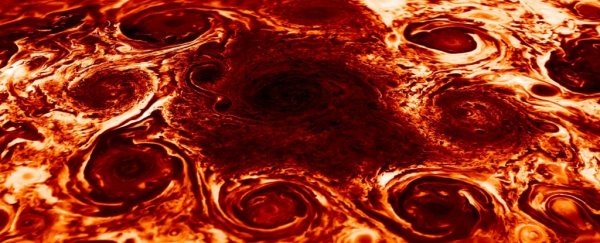Jupiter, thick with chaotic clouds and raging with wild winds, is famous and beloved for its gloriously stormy atmosphere. Ever since the Juno space probe arrived there in 2016, we've had unprecedented access that's been helping us understand what drives the gas giant's insane weather.
But Juno has delivered not just answers, but also more questions. Until the Juno mission, we hadn't been able to get a good look at Jupiter's poles. What the space probe saw there was a jaw-dropper: polygonal arrangements of storms at both north and south, circling a storm in the centre.
At Jupiter's north pole, nine cyclones rage, one in the centre, and eight others arrayed neatly around it, all spinning in a counterclockwise direction.
At the south pole, Juno spotted six storms in 2016, one in the centre, and five arrayed around it. A seventh storm joined the fray sometime in 2019, so now there are six vortices in a hexagonal shape surrounding the central storm. These southern storms are all spinning clockwise.
Since 2016, these huge storms - comparable in size to mainland United States - have persisted, unmerged. And now, as laid out in a new paper, we might finally have a clue as to why.
Jupiter's arrangement is dissimilar to the other gas giant in the Solar System, Saturn, which only has a single, huge storm at each of its poles. It's unlike the processes on Earth, too - on our planet, most cyclones form at tropical latitudes, and drift towards the poles, but they dissipate over land and cold ocean zones before they get there.
Since Jupiter has neither land nor cold oceans, it makes sense that its storms would behave differently from Earth, but the question remains - why don't they merge to create single storms a la Saturn?
Astronomer Cheng Li of the University of California, Berkeley and his colleagues from Caltech ran numerical simulations of the storm configurations, and discovered a set of conditions under which the storms can remain discrete and stable for long periods of time without smooshing together into a mega-storm.
It's basically a "Goldilocks zone" for Jovian storms.
"We find that the stability of the pattern depends mostly on shielding - an anticyclonic ring around each cyclone - but also on the depth," the researchers wrote in their paper.
"Too little shielding and small depth lead to merging and loss of the polygonal pattern. Too much shielding causes the cyclonic and anticyclonic parts of the vortices to fly apart. The stable polygons exist in between."
The team used equations that describe the movement of a single layer of fluid on a sphere, and modelled the polygonal arrangements of vortices. This is not a new thing, but the team added polar geometry and beta drift - the tendency of cyclones to drift due to an increase in the Coriolis force with latitude due to wind speed - into their models, for a more detailed understanding of the dynamics at play on Jupiter.
According to their findings, there are two things at play, and conditions for both have to be just right. The first is, to a smaller extent, the depth of the cyclone - how far it reaches down into the Jovian atmosphere. Too shallow, and the storms will merge.
But the biggest influence on the storms' sticking power is a phenomenon known as vortex shielding. This is when the vortex - in this case, our Jovian cyclones - is surrounded by a ring moving in the opposite direction. So, each of the counterclockwise cyclones on the north pole is surrounded by a powerful wind blowing around the cyclone in a clockwise direction.
If this shielding is too weak, the storms will merge. If it is too powerful, the storm and its shield will fly apart from each other, resulting in a total storm mess. So, in order to persist, both the depth of the cyclones and the strength of their vortex shields have to be just right.
And thus, another set of mysteries.
"There are many questions we have not answered," the researchers wrote.
"We have not explored how the cyclones form - whether they form in place or drift up from lower latitudes. Additionally, we have not explained how a steady state is maintained - why the number of cyclones does not increase with time. Furthermore, we have not determined how shielding develops, or why only the Jovian vortices are shielded."
The team is yet to test their models on actual Juno data. Doing so, however, could lead us to some answers to these deeply intriguing questions.
The research has been published in the Proceedings of the National Academy of Sciences.
